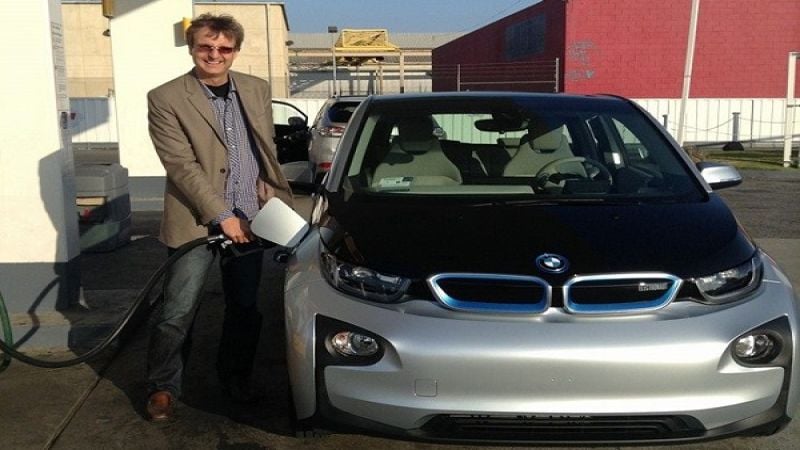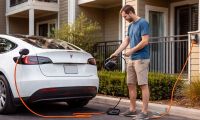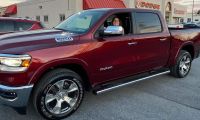New owners of the BMW i3 with a range extender, called the REx, are reporting an interesting new trend. They are reporting that the gasoline powered range extender in their electric car is enabling them to travel many more miles on electric power alone than they would have been able to if the car were purely electric. The people reporting this are not internal combustion engine (ICE) car drivers who grudgingly chose an EV for purely economic reasons. These are some of the most outspoken advocates of electric automobiles in America.
This may seem odd at first. How can a car with a gasoline engine make an EV go further on its charge of electricity? It doesn’t. However, what it does do is give owners the confidence to drive their EV up to, and past, the full electric range. This has profound implications for those wishing to reduce the amount of gasoline used in the US.
A little bit of background to this story is found in our recent stories highlighting the fact that sales of electric vehicles with some form of range extender (PHEV, EREVs, etc.) are now outpacing battery electric vehicle sales (BEVs). In fact, although the data is still just coming in, the BMW i3 seems to a perfect mirror of the overall industry in that regard.
Scenario One – Closest Recharge Is Just Out Of Range
Imagine a trip that one would like to take in their EV, but which would be a few miles past their maximum range on battery power. The battery electric (BEV), pure electric vehicle, owner has choice. Take the EV and try to find a charge along the way, or take an ICE car. The Rex owner can just go for it. Their range extender may kick in and use a few sips of gasoline, but that is surely better than taking an ICE car isn’t it?
This situation can also be one of convenience. Imagine an EV owner who is making a trip that requires an on-time arrival at or near their maximum range. Stopping for a charge might be an option, but at what cost in time? Why not push the REx and use some gas if needed. Maybe you will get lucky and not need to use the range extender? Stopping to charge may take longer than the time allowed and again, this is better than driving the other car in the stable is it not?
Scenario Two – Charger Off-Line
The day this story was written an owner reported in the Facebook i3 club that they arrived at a charging location they were counting on only to find a local yahoo in an ICE car had been doing donuts in the parking lot and knocked over the charge station. Many EV drivers report that the spots are sometimes taken by ICE cars. Now what would an EV driver do? In a BEV he scrambles to find another location. In a REx he drives on and charges when convenient.
What Do Real Owners Say
George Betak, an electric vehicle writer and EV advocate, recently said in an i3 club post about a long road trip he took, “220 miles so far. About 2 gallons of gas consumed and 70 miles driven in range extended mode. The Rex rocks, at least in our experience.” In another post, he and others were having a dialogue on the benefits of the range extender where charging points are spotty and said “Some of these trips would be simply too tiresome to attempt, and the other alternative in most cases is a gas car or a lesser plugin hybrid. So in that sense, the i3 REx is facilitating longer journeys, and more EV miles. We could have driven more total EV miles that day, but the charging stations we wanted to use were either busy or unavailable.” George and fellow owners have said that the number and availability of the charging stations they would like to use is a “gating factor” to fleet EV miles that could be travelled. The REx solves this issue.
Similarly, an owner named Krishnamurty Kambhampati commented about using the i3’s range extender to allow for EV miles travelled saying, “1000 awesome miles on the i3!. I have consumed about eight REx miles. If I did not have the REx I would have done at least 200-300 ICE miles as I would have opted to ICE the trip. This ratio will change as cooler temps come later this year. Rex was a good choice for my use.”
Scenario Three – The Unexpected Journey
Another i3 Rex owner gave us another scenario where a range extender might add EV miles. Alex Lee had just arrived at work when a co-worker said they needed to head right out of the office. Alex had been letting his his i3 REx’ battery drain because it was headed in for service. Without the range extender he would not have been able to take his car on the business call. They were able to hop in the range-extended i3 due to its capability of continuing on after the charge ran out. Alex said “This was my first experience to use the on board range extender engine. It worked out great!”
What Do BEV Owners Think?
It is not uncommon to see negative comments posted under stories about electric vehicles with some form of range extender authored by “pure” electric battery electric vehicle advocates. If you doubt this, please read David Murray’s article in Inside Evs in which he recounts a first-hand insult delivered to him by a fancy BEV owner about his Volt. The irony is that people who share this BEV driver’s attitude about range extenders may be influencing buying decisions in a way that reduces electric miles driven.
Marketing works and some automakers have been trying to plead their case about the possible benefits of PHEVs. Toyota recently ran the Nurburgring in a Prius Plug-in. Over the 12.9 miles of the course, the car used 5 tablespoons of gasoline. The stunt was surely intended to show the car could make the trip on its battery alone. Instead, it highlighted perfectly how PHEVs can embolden EV owners to really push their vehicles to the limits of the electric car’s limited all-electric capabilities, while not worrying about finishing the journey. At the end of the day is the objective more electric miles driven, or not? If you are an EV owner or future owner, we’d love to have your feedback.
Related Stories:
2014 Toyota Prius Plug-in completes Nurburgring using 5 tablespoons of gas
Green cars' 2014 sales decline in the US, but overall US fleet MPG goes up
Main story image courtesy of George Betak. Credit for smaller photos shown when clicked to view.
The author received permission to use the full name of those mentioned in the story.













Comments
Great story, John. It's one
Permalink
Great story, John. It's one of the more underreported aspects of the EV industry, and I agree with your take on the subject. It certainly appears as though plug-in hybrid choices will proliferate much faster than BEV choices in the foreseeable future.
I'm the proud owner of an i3
Permalink
I'm the proud owner of an i3 REx (since the start of March). I've been averaging 2000 miles per month in it, and although many of my journeys involve an element of REx running (I'm logging what proportion), the REx allows me to use the car as my only vehicle, whereas if it was a pure BEV I wouldn't have bothered.
My longest trip has so far been 335 miles in one day, with no opportunity to recharge at any stage - used around 25 litres of gasoline (5.5 UK gallons) and a full charge, so around 50mpg when running on the REx, even at motorway speed.
So, the long and short is that I agree with the article 100%, and I'm COMPLETELY convinced that REx electric is the sensible, pragmatic solution.
You've hit the nail on the
Permalink
You've hit the nail on the head here. We have an i3 REx with about 1,850 miles on it, of which 1,450 are electric. Around town, it runs 100% on electricity. But every couple weeks, we take it on a 195-mile one-day round trip. No charging stations along the way. Without the REx, we'd be using our ICE car for that trip instead. We get the first 72 miles of freeway driving on the battery, the rest on the REx. (For that situation, I do wish we had the flexibility of the European model to decide when to use the REx and when to use the battery as well as the larger 9-liter European gas tank. And we're in a non-CARB state, so the modifications BMW made to qualify the car as BEVx in the CARB states (7-liter tank instead of 9 liters and no control over when to use the REx) do us no good. Hear that BMW?)
But there's another possible benefit of the REx--longer total battery life. I understand that the best way to store a lithium ion battery is at less than a full charge; the common recommendation is around 50%. That has some benefit for total battery life, though probably not a huge benefit. So when we don't need a lot of range the following day, we'll let it sit overnight at about a half-charge. If plans unexpectedly change the next day and we need more range, we've got the REx. Without the REx, we'd be charging it to 100% every time we pull into the garage.
Very interesting Paul - I
Permalink
In reply to You've hit the nail on the by Paul Durham (not verified)
Very interesting Paul - I hadn't realised that the US-spec gas tank is even smaller. Not everything in the US is bigger ;-). The ability to switch the REx on / off as required is a key element of the usability from my perspective - maybe I am a bit more "lazy" because I have that facility, but it also means I'm less anxious (because I can still make progress at 70mph-ish).
In terms of the batteries, I would always try to leave them at 100% - it does no harm at all, and assuming the battery management system behaves in a conventional fashion, the pack will go into a balancing mode once it reaches 100% SOC, which will help keep the pack running at maximum capacity. I'm sure BMW have a strategy that would prevent damage on very low SOCs, but I try to avoid letting the pack get below ~15% since it's the low SOCs that are likely to reduce battery life rather than keeping them topped up (the life of a battery drained regularly to <20% SOC will be considerably shorter than one where it's kept above, say, 50%).
That is true, although when
Permalink
In reply to Very interesting Paul - I by Nick Carpenter (not verified)
That is true, although when your display reads 15% battery remaining that doesn't necessarily mean the SOC is actually 15%. The automakers build in buffers on either side, so when it reads 15% for the driver it might actually be 25%. The car will still be effectively out of battery when the display reads 0%, but only because it is designed that way to protect the battery.
I wish more people thought
Permalink
In reply to That is true, although when by Luke Ottaway
I wish more people thought like that. Not here in this comment string, but in so many we see non-engineering folks stating absolutes as if they apply to consumer goods. Luke is right. Makers of things (cars in this case) are not crazy enough to let users mess up equipment with bad habits. My favorite post in a while. That said, I never let my cell phone go below 50%! Thanks
Excellent observations and I
Permalink
Excellent observations and I agree with the conclusions. I do find it interesting that the article suggests that this a novel finding among PHEV owners. While it's certainly true for the i3-REx owners (which I'm soon to be myself), the Volt community has been enjoying this advantage for some time. I'm proud that in the last 3+ years I was able to rack up over 25K of pure EV miles with 29K total, over 86%. Having the extended range offered more opportunities to drive longer distances, maximize my EV range, yet find opportunities to charge.
Driving a BEV (been doing that for a long time as well) has always been somewhat of an adventure for longer distance travel. The key point is about the predictability of charging when you go beyond the "point of no return" (below 50% SOC). With the increasing popularity of plug-in vehicles, particularly in Southern California--the public charging infrastructure has become increasingly oversubscribed, reducing predictability. That serves as a deterrent for those who have trepidation about mapping out new locations with uncertain charging reliability.
One finding not mentioned in the article is the type of drivers we now encounter who drive PHEVs. These individuals are "regular" drivers who didn't have a lot of knowledge about how EVs work. They just were looking for transportation that held advantages (e.g., fueling costs, solo HOV lane usage) over traditional ICE vehicles. That is certainly a good thing for the EV Movement, adding new converts to our ranks.
David
Regarding the battery buffer
Permalink
Regarding the battery buffer and degradation: while this is headed in the right direction, some of the information is not quite correct. Take the Nissan LEAF, for example. There is a 4-5% buffer on the top. Meaning that when the customer charges the traction battery to full, the total stored capacity and voltage are below the physical maximum. Likewise, when discharging the cells, the cutoff voltage for turtle mode is quite high, and very safe. There is little energy left in the pack, about 2-3% of its maximum stored energy. It's critical to disconnect the traction battery from the rest of the vehicle at that stage, because if it continued to discharge through parasitic losses, for example, the voltage would quickly drop, and the battery could suffer irrecoverable damage.
From a consumer perspective, it really does not matter if you charge the battery to full or how often you have driven the car to turtle mode. Both end points have very safe limits and other safeguards in place. In terms of longevity, unless you were turtling the vehicle every day, and left it in that state until early morning, you most likely won't see any measurable impact on the battery at all.
Please keep in mind that we have been conditioned to different type of battery chemistries over our lifetime. Lead-acid batteries like to be stored fully charged, and hate deep discharges. NiCd batteries want to by cycled fully, and should not be recharged unless they were nearly empty, because they will lose more capacity due to their memory effect. Lithium-ion batteries, like what's in modern EVs, like to sit half-charged, especially in storage. They also prefer shallow cycles, but won't mind occasional deep cycles at all. While the cycle type will affect the life of the battery, it's not the most critical factor.
I would simply use these traction packs in the most practical way possible, and not worry much about them. When going on vacation, I would ensure that the pack was at most half-charged, the vehicle was parked in a cool place, and the battery was conditioned (cooled) if possible.
Thanks for adding this George
Permalink
In reply to Regarding the battery buffer by George B (not verified)
Thanks for adding this George. Well said.
Pure electric cars are not
Permalink
Pure electric cars are not lab experiments... they tell us the truth about the true nature of sustainability, as solar and wind can only provide a fraction of what our fossil fueled lifestyle can provide.
Hybrids are a lame attempt at lying about that... as in packaging a hard pill with sweets. And the proud owners are stuck with neither option being as good as each separately (as a pure BEV doesn't carry the added weight of the ICE engine, and a pure ICE lets you still party while the oil is flowing, without the expenses of a battery pack)
In practice most plugin hybrids I know rarely charge from the grid at all... because they just can. I wouldn't be surprised if the number is around 90%+
I own a BMW i3 BEV and I am one of those criticizing the gasoline option... and I live happily with it as my sole ride.
I do a 100 miles per day commute each way and I always have 20 miles of reserve and most charging stations are reliable. Just THINK and PLAN. Simple.